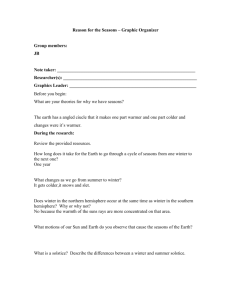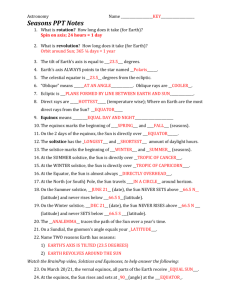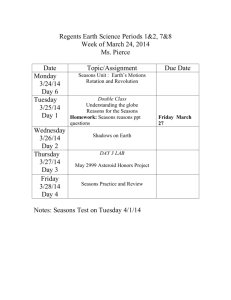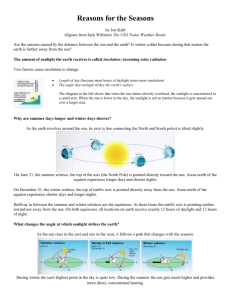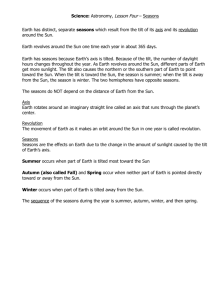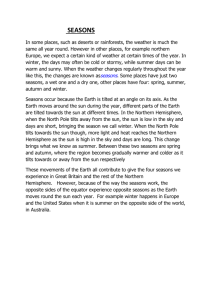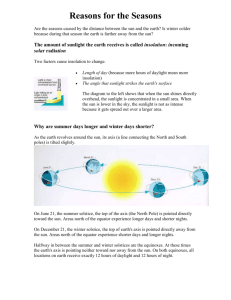Seasons Lesson Plan
advertisement
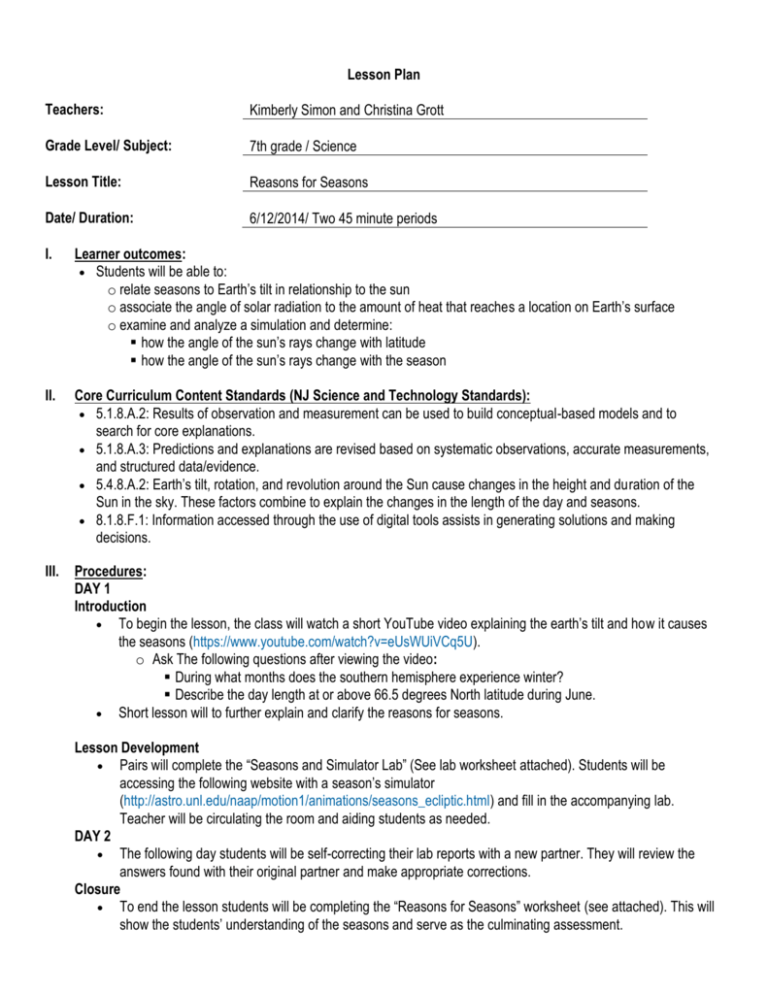
Lesson Plan Teachers: Kimberly Simon and Christina Grott Grade Level/ Subject: 7th grade / Science Lesson Title: Reasons for Seasons Date/ Duration: 6/12/2014/ Two 45 minute periods I. Learner outcomes: Students will be able to: o relate seasons to Earth’s tilt in relationship to the sun o associate the angle of solar radiation to the amount of heat that reaches a location on Earth’s surface o examine and analyze a simulation and determine: how the angle of the sun’s rays change with latitude how the angle of the sun’s rays change with the season II. Core Curriculum Content Standards (NJ Science and Technology Standards): 5.1.8.A.2: Results of observation and measurement can be used to build conceptual-based models and to search for core explanations. 5.1.8.A.3: Predictions and explanations are revised based on systematic observations, accurate measurements, and structured data/evidence. 5.4.8.A.2: Earth’s tilt, rotation, and revolution around the Sun cause changes in the height and duration of the Sun in the sky. These factors combine to explain the changes in the length of the day and seasons. 8.1.8.F.1: Information accessed through the use of digital tools assists in generating solutions and making decisions. III. Procedures: DAY 1 Introduction To begin the lesson, the class will watch a short YouTube video explaining the earth’s tilt and how it causes the seasons (https://www.youtube.com/watch?v=eUsWUiVCq5U). o Ask The following questions after viewing the video: During what months does the southern hemisphere experience winter? Describe the day length at or above 66.5 degrees North latitude during June. Short lesson will to further explain and clarify the reasons for seasons. Lesson Development Pairs will complete the “Seasons and Simulator Lab” (See lab worksheet attached). Students will be accessing the following website with a season’s simulator (http://astro.unl.edu/naap/motion1/animations/seasons_ecliptic.html) and fill in the accompanying lab. Teacher will be circulating the room and aiding students as needed. DAY 2 The following day students will be self-correcting their lab reports with a new partner. They will review the answers found with their original partner and make appropriate corrections. Closure To end the lesson students will be completing the “Reasons for Seasons” worksheet (see attached). This will show the students’ understanding of the seasons and serve as the culminating assessment. IV. Modifications/Accommodations: Conferring One on one assistance when necessary Teacher modeling Visual examples Repetition of directions for clarification Adjust questioning based on ability Student rephrasing V. Assessments: Formative assessment: o Student questions o Video question responses Summative assessment: o Lab o Reasons for the Seasons worksheet VI. Materials/Technology Used in Lesson: 1. Lab (see attached) 2. Computer with Project 3. YouTube Video: Earth’s Tilt 2: Land of the Midnight Sun 4. Seasons Simulator 5. Individual student Ipads or computers 6. Reasons for Seasons Worksheet (see attached) Name _________________________________ Date ___________ Period _____ SEASONS AND ECLIPTIC SIMULATOR Overview: In this lesson, students access an online simulator to aid in understanding the relationship between seasons and Earth’s tilt and the day/night cycle caused by Earth’s rotation. Objectives: The student will: • relate seasons to Earth’s tilt in relationship to the sun; • associate the angle of solar radiation to the amount of heat that reaches a location on Earth’s surface. Background: The sun is the main source of energy for Earth’s climate system. The sun’s radiation provides heat and light. Earth rotates, or spins, causing both day and night. Earth’s axis, an imaginary line that runs from the North Pole to the South Pole, is tilted. This makes days longer in the summer in the Northern latitudes and shorter in the winter. Latitude is a measurement of distance from the equator. Earth revolves, or circles, the sun. The combination of Earth’s tilt and revolution around the sun create seasons. During the summer, the North Pole tilts toward the sun and in the winter, it tilts away. As the sun rises higher in the sky in the summer in the regions around the North Pole, the sun’s radiation becomes more direct and heats the surface more. The sun’s rays are direct when they are perpendicular to Earth’s surface. The rays meet Earth’s surface at a right angle (90) The sun’s rays are not direct when they are parallel to Earth’s surface. Parallel lines never intersect, or cross each other. 1. The most direct sunlight is _______________________ to Earth’s surface. a) perpendicular b) parallel Directions: Access the MULTIMEDIA: “Seasons and Ecliptic Simulator” on Mrs. Simon’s website and move the settings in the different boxes to view the changes of seasons and angles of sunlight received on various locations on Earth, and then answer the questions below. 1. Move the stick figure in the upper right box of the Seasons and Ecliptic Simulator. As the stick figure is dragged towards the poles, does the amount of direct sunlight increase or decrease? __________________________ 2. What is the latitude of Wyckoff, NJ? ___________________ 3. Draw arrows in the boxes to show of the angle of sunlight for Wyckoff. A. Equinox B. Summer Solstice C. Winter Solstice 4. Which of these locations might receive sunlight that is parallel to the Earth at different times of the year? A. Anchorage, AK; latitude 61.2° N C. Barrow, AK; latitude 71.3° N B. Honolulu, HI; latitude 21.3° N D. Seattle, WA; latitude 47.7° N Why? __________________________________________________________________________ ___________________________________________________________________________ 5. Move the stick figure to the equator. Drag the red arrow on the calendar to answer the following question. During what two dates does a person standing at the equator experience the most direct sunlight? ________________________________ ____________________________________ Would these two dates be considered equinoxes or solstices? _______________________________ 6. Drag the stick figure to Wyckoff’s latitude. In the lower right box, select “view from side”. Use the sun’s altitude, and the angle of the sun in the sky to complete the box below. Day Spring equinox March 21 Summer Solstice Autumn Equinox Winter Solstice June 21 September 21 December 21 Sun’s Altitude() DRAW the Sunbeam Spread 7. How are the sun’s altitude and the direction of the sunlight related? _________________________________________________________________________________________________ _________________________________________________________________________________________________ _________________________________________________________________________________________________ 8. When it is winter in NJ, which pole experiences 24 hours of darkness? _________________ 9. When it is winter in NJ, which pole experiences 24 hours of daylight? _________________ 10. EXPLAIN why do the North and South poles experience 24 hours of daylight (midnight sun) or 24 hours of darkness (polar night? _________________________________________________________________________________________________ _________________________________________________________________________________________________ _________________________________________________________________________________________________ 11. Use the simulator to complete the table below. For each latitude write a short paragraph which describes the variations in sunlight (seasons) that are experienced at this latitude throughout the year. Latitude 0 23.5 N 41.0N 44.0 S Description of Yearly Pattern of Sunlight At noon the sun’s angular height above the horizon ranges from 90 on the vernal equinox, to 66.5 on the summer solstice. The autumnal equinox is also 90 and the winter solstice is 66.5. Thus, the equator receives very direct sunlight throughout the year. The most direct sunlight occurs during the equinox when there is equal day and night.



